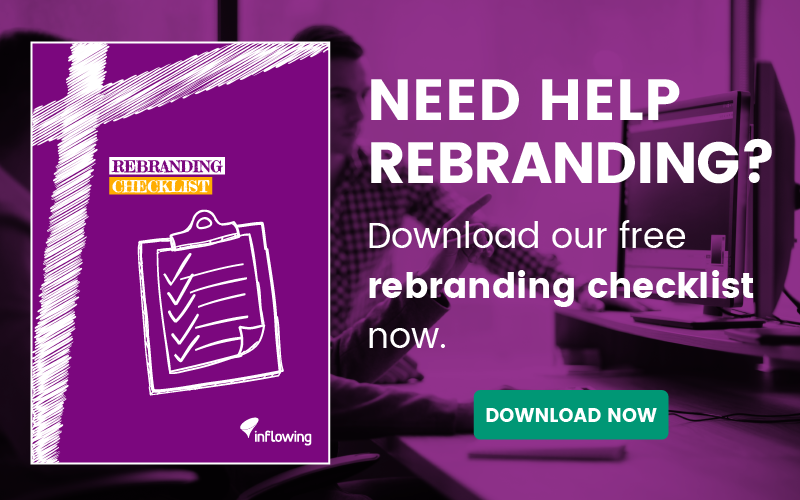As marketers, this is why we got into the game. It’s time to reimagine the company’s core visual identity, and begin an exciting new chapter – with you in the driving seat. Adrenaline is flying around, and getting carried away in the moment is what it’s all about.
STOP! Before you go too far with mind mapping, mood boards, feedback forums and the like – it’s worth checking out our of the top 4 B2B logo design pitfalls.
Here goes!
Drop shadows
A long standing Adobe effect, drop shadows can be an alluring for some new B2B logos.
Beware! They can be really difficult to print consistently. Depending on the print technique and size of print involved, the outcome can vary massively. There will be instances where it also may not be possible to show a drop shadow. For example, if the logo is being embroidered onto a t-shirt. This is because the embroidery process requires a solid colour and a drop shadow is made from a varying range of colour tints which isn’t replicable through embroidery.
For your logo to land and become a recognisable symbol of your business, it must be consistently applied across the different channels. There can be no compromise.
Too many colours
Having too many colours is a pitfall that many organisations fail to recognise going into a new B2B logo design process.
There are a number of reasons why it’s to be avoided.
From a process perspective, although digital print is becoming way more popular in almost all areas of printing nowadays, there are still some occasions where litho printing is needed – either for effect or out of necessity. Because of the way that litho printing works (mixing together four base colours) when the plates are set up for these jobs, you end up paying extra money for each colour that you use.
From a design perspective, less is usually more. The most impactful logos are often simple and unfussy. Packing a logo out with all the colours of the rainbow might seem a good idea initially, but when executed within branding documentation and collateral, it can almost end up too much for the person seeing it to take in. With a number of colours, you’ll also lose the opportunity to contrast to background colours when placing it within artwork, which will likely end up making your corporate communications and marketing collateral lack that all-important ‘pop’.
If your B2B organisation’s culture is colourful, and you want to represent that within your shiny new branding, you should look elsewhere. Perhaps think how to introduce a more colourful visual identity in the wider visual style: think photography and colour palette rather than the logo itself.
Unreadable font
This is the one that leaves me with my face in my hands. Out of the whole list, I personally think it’s the most unforgivable and franky dangerous to a brand’s survival. Yet a walk around any B2B conference will be a stark reminder that this NEEDS to be in any list of B2B logo design pitfalls.
If your logo redesign includes reimagining your font, then make sure people can read what it says. I’m aware how basic that sounds, but basic is good.
This failing is particularly common in B2B organisations trying to convey a ‘premium’ feel to their brand. Fancy calligraphy and a handwriting style should be used with extreme caution.
Getting it wrong can cause people to be not only deeply confused about your brand positioning, but left wondering who the hell your company is.
As marketers and custodians of an organisation’s identity, we want people to build a positive image of our organisation that fits with our intended position in the market. With writing that no one can read, this will never happen. Again – less is more here.
If you want to get across the premium nature of your organisation, do it using amazing photography, testimonials on your website from other premium brands, and high quality print finishes and paper styles for your stationary and printed collateral.
Thin line work
Be careful when drawing your shapes out, or outlining (using a stroke) on your company name or strapline.
Thin lines in logos that look like a design dream on screen can end up looking like a print nightmare.
Fussy detail like this can end up being lost completely when it comes back from the printers – depending on the print process that they use. Reprographics folks might then end up having to thicken out the lines to get them to appear, which will ultimately lead to a different version of the logo you spent so long on.
Brand inconsistency is never cool.
Don’t get caught in a trap of thinking you can be ‘heavily inspired’ by a B2B logo from a different industry market, and apply it to yours. If you think no one will notice, trust me they will. And people will be enjoying your logo, and possibly sharing it on social media, for all the wrong reasons. Charli Parkes, our Head of Digital is an eagle eyed logo doppelganger spotter. It’s worth also remembering that companies’ reputations rise and fall, so there’s definitely risk in having a logo that looks like someone else’s.
Make sure you do your research at the front end when coming up with a logo. You’re trying to create a visual identity that represents your organisation’s identity, yes. And for it to end up being a recognisable brand element – it has to be distinctive. It has to stand out from the crowd as something which is unquestionably yours.
B2B logo design that works
Following Inflowing’s model for B2B logo design:
Keep it C.E.R.S
- Clean
- Easy to replicate
- Readable
- Simple
If you’re looking to a rebranding project, download our checklist now. We advise not only on what to think about for your logo, but your wider brand, messaging, and positioning too. It’s the must have document for B2B organisations embarking on a rebranding project.
Beyond that, if you have a branding brief – share it with us. We’d love to be part of your exciting new journey.

